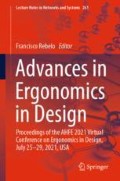Abstract
Scenario-based design thinking aims to improve students’ design ability, creativity as well as learning transfer ability by the improvement of teaching techniques, innovation of teaching methods and teaching practice. The “Little Sun” stroller design project is introduced into the teaching practice process. Different scenario prototypes are completed and tested after understanding and exploring the scenario, and researching the needs and prioritizing them to create new ideas. The above process can be cyclical, showing a non-linear characteristic. This product design teaching practice research is based on real projects, which is an active exploration and useful attempt for scenario-based thinking in industrial design professional courses.
Access this chapter
Tax calculation will be finalised at checkout
Purchases are for personal use only
References
Mosely, G., Wright, N., Wrigley, C.: Facilitating design thinking: a comparison of design expertise. Think. Skills Creat. 27, 177–189 (2018)
Carroll, J.M.: Five reasons for scenario-based design. Interact. Comput. 13(1), 43–60 (2000). https://doi.org/10.1016/S0953-5438(00)00023-0
Fati, W., Shihua, H., Baoyuan, Y.: Scenario: a new idea of learning service design. E-Educ. Res. 39(12), 63–69 (2018)
Simon, H.: The sciences of the artificial, 3rd edn. MIT Press, Cambridge, MA (1996)
Brown, T.: Design Thinking for Educators. IDEO Corporation, New York (2011)
Wang, Y., Hu, W., Tang, J.: Research on scenario theory in product interaction design. Packaging Eng. 38(6), 76–80 (2017)
Author information
Authors and Affiliations
Corresponding author
Editor information
Editors and Affiliations
Rights and permissions
Copyright information
© 2021 The Author(s), under exclusive license to Springer Nature Switzerland AG
About this paper
Cite this paper
Wang, C., Hu, K., Zeng, L., Weng, C. (2021). The Application of Scenario-Based Design Thinking in Product Design Teaching Practice. In: Rebelo, F. (eds) Advances in Ergonomics in Design. AHFE 2021. Lecture Notes in Networks and Systems, vol 261. Springer, Cham. https://doi.org/10.1007/978-3-030-79760-7_57
Download citation
DOI: https://doi.org/10.1007/978-3-030-79760-7_57
Published:
Publisher Name: Springer, Cham
Print ISBN: 978-3-030-79759-1
Online ISBN: 978-3-030-79760-7
eBook Packages: EngineeringEngineering (R0)

